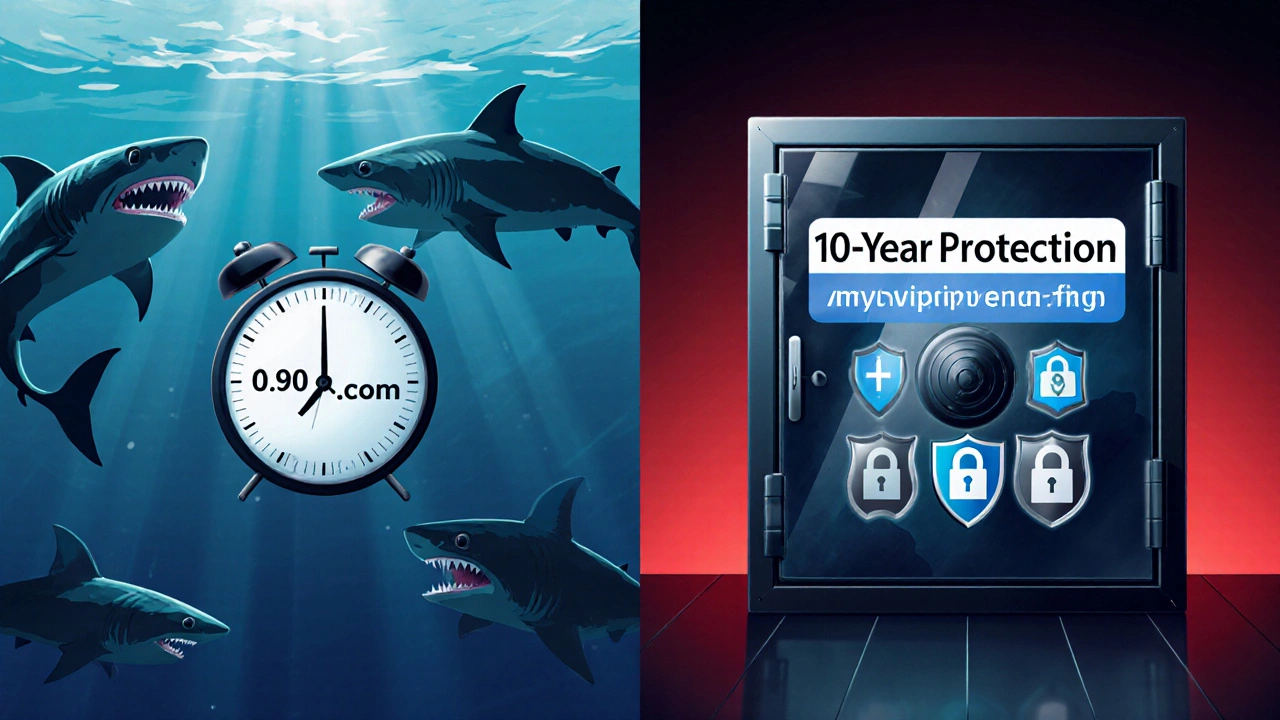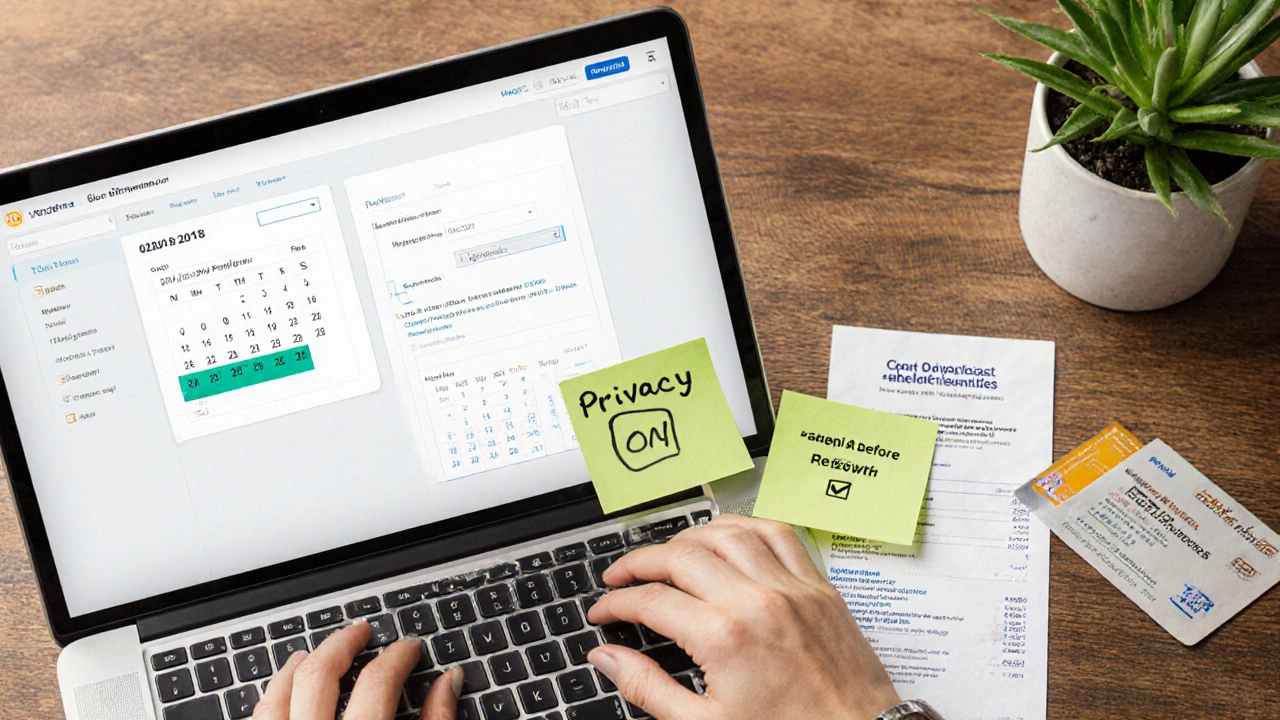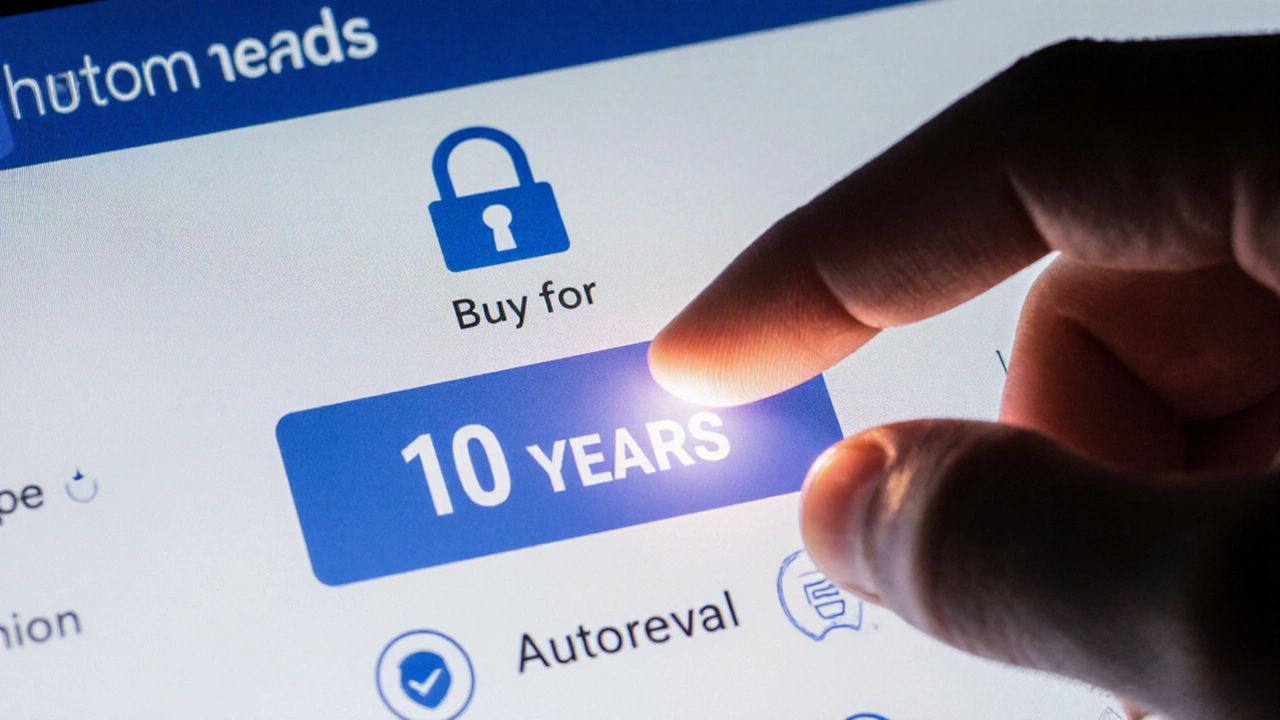Domain Cost Calculator
See how much you could save by registering for 10 years instead of renewing annually. Many registrars increase prices after the first year.
Renewal Risk Alert
Remember: If you miss a renewal, your domain enters a 90-day grace period where it could be snatched by domain squatters for $80-$150 in redemption fees. Always enable auto-renewal!
You can’t buy a domain name forever. Not really. Not even Amazon, Google, or Apple can do it. But you can lock it in for decades - and avoid the nasty surprises most people get when their domain expires and someone else snaps it up.
Every domain you own is leased, not owned. It’s like renting an apartment in a city where the landlord changes every year. The good news? You can pre-pay for up to 10 years at a time. That’s the closest thing to permanent you’ll ever get.
Why You Can’t Buy a Domain Forever
The internet doesn’t work like buying a house. Domains are managed by global organizations - ICANN - and registered through companies called registrars. These registrars (like GoDaddy, Namecheap, Google Domains) don’t own the domains. They just act as middlemen between you and the domain registry.
Every domain - .com, .co.uk, .net - has a registry that controls it. For example, Verisign runs .com. These registries only allow registrations in blocks of 1 to 10 years. No more. No less. Even if you pay $10,000 upfront, you still can’t get 11 years. It’s not a loophole. It’s the rule.
So when someone says they sold you a domain “for life,” they’re either lying or selling you a service that auto-renews. That’s not ownership. That’s a subscription with a fancy name.
How to Lock In Your Domain for as Long as Possible
Here’s the real trick: pre-pay for the maximum allowed time - 10 years - and set up auto-renewal as backup.
- Choose a reputable registrar. Stick with known names like Namecheap, Google Domains, Porkbun, or Cloudflare. Avoid the flashy ones with $0.99 first-year deals - they’ll jack up the price after year one.
- Search for your domain. Type in exactly what you want - e.g., yourbusinessname.com. Check if it’s available. If not, try variations like yourbusinessname.co.uk or yourbusinessname.online.
- At checkout, look for the registration period option. Select 10 years. That’s the longest allowed.
- Enable auto-renewal. Even if you forget, your domain won’t vanish. Most registrars will charge your card automatically 30 days before expiration.
- Turn on privacy protection. Your contact info is public by default. Spam bots crawl it. Pay the small fee (usually $2-$10/year) to hide your email and phone number.
For example, if you buy a .com domain for $12/year and lock it in for 10 years, you pay $120 upfront. That’s cheaper than paying $12 every year for a decade - and you’ll never get a renewal reminder that makes your heart skip.
What Happens If You Don’t Renew
Most people think their domain just disappears. It doesn’t. It goes through a 90-day death spiral:
- Day 0-30: Domain expires. Your website goes down. Emails stop working.
- Day 31-60: Redemption period. You can still get it back - but it’ll cost you $80-$150 extra, depending on the registrar.
- Day 61-90: Pending delete. The domain is released back into the pool. Anyone can buy it.
That’s when the sharks show up. Domain squatters use bots to grab expired domains in seconds. If your domain has traffic, brand recognition, or backlinks - it’s gone forever. Someone else will own it. You’ll have to start over.
One client of mine lost mylawyer.uk because he missed a renewal email. Three weeks later, it was listed on a domain auction site for £2,500. He didn’t even want to buy it back. He just wanted to know why it happened.

How to Avoid Missing Renewals
Renewal emails go to your spam folder. They get lost. You forget. Here’s how to fix it:
- Use a dedicated email for domain registration. Not your personal Gmail. Not your work email. Create something like [email protected].
- Set calendar reminders. Add two reminders: one 60 days before renewal, one 7 days before.
- Link your domain to a password manager. Tools like 1Password or Bitwarden can track renewal dates and send alerts.
- Check your registrar’s dashboard every six months. Don’t wait for an email.
Also, make sure your payment method is valid. If your credit card expires or gets declined, auto-renewal fails. Update it before it’s too late.
Which Domain Extension Should You Choose?
.com is still king. But it’s not the only option - and sometimes not the best.
If you’re in the UK, .co.uk is trusted locally. It signals you’re a British business. Google also gives local domains a small ranking boost in UK searches.
.io and .ai are popular with tech startups. But they cost more - often $30-$50/year. Only pick them if your brand fits the vibe.
.shop, .store, .online - these are cheaper and descriptive. But they don’t carry the same weight as .com. If you’re building a serious brand, stick with .com or .co.uk. Use newer extensions for side projects.
What to Do If Your Dream Domain Is Taken
It happens. All the good names are gone. Here’s what to do instead:
- Add a word: getmywebsite.com, mywebsiteuk.com
- Use a different extension: yourbrand.co.uk or yourbrand.io
- Use a hyphen: your-brand.com (but avoid this - it looks spammy)
- Buy it from the current owner. Use a marketplace like Sedo or Afternic. Prices range from $50 to $50,000. Don’t pay more than 3x your annual marketing budget.
Don’t waste time arguing with the owner. Most are just holding it for profit. If they’re asking $10,000 for a name you could replace with yourbrand.co.uk, walk away.

How to Transfer Your Domain Safely
Want to switch registrars? Maybe you found a better deal? No problem.
- Unlock your domain in your current registrar’s dashboard.
- Get the authorization code (EPP code). It’s usually under “Transfer Domain.”
- Go to your new registrar and start the transfer process.
- Enter the EPP code. Confirm the transfer via email.
- Wait 5-7 days. The domain will auto-renew for one extra year during transfer.
Important: Don’t initiate a transfer within 60 days of registering or renewing. ICANN blocks it. You’ll have to wait.
Domain Privacy: Don’t Skip This
Your name, address, phone, and email are public on WHOIS databases. Spammers, scammers, and even local salespeople use this to target you.
Domain privacy hides your info behind the registrar’s details. For $2-$10/year, you avoid:
- Unwanted calls from “domain renewal services” that aren’t your registrar
- Spam emails disguised as official notices
- People trying to steal your domain by pretending to be you
Some registrars offer it free. Namecheap does. GoDaddy charges extra. Always check before you buy.
Final Checklist Before You Hit Buy
Before you pay:
- ✅ Is the domain exactly what you want? No typos.
- ✅ Is it .com or .co.uk? (Or another trusted extension)
- ✅ Are you paying for 10 years?
- ✅ Is auto-renewal turned on?
- ✅ Is privacy protection enabled?
- ✅ Is your payment method active and valid?
- ✅ Have you set calendar reminders for renewal?
If you answer yes to all of these, you’ve done everything humanly possible to keep your domain safe. No one can guarantee you’ll own it forever. But you’ve made it as permanent as the internet allows.
Can I buy a domain name forever?
No, you can’t buy a domain name forever. Domains are leased in blocks of 1 to 10 years. The longest you can register at once is 10 years. After that, you must renew. But you can set up auto-renewal and pay upfront for 10 years to avoid expiration surprises.
What happens if I forget to renew my domain?
If you forget to renew, your domain enters a 90-day grace period. First 30 days: your site goes down, but you can renew at the regular price. Days 31-60: you can still recover it, but you’ll pay a $80-$150 redemption fee. Days 61-90: the domain is deleted and becomes available for anyone to buy - often snapped up by domain squatters within minutes.
Is it better to buy a domain for 10 years or renew yearly?
Buying for 10 years is almost always better. You lock in today’s price and avoid future rate hikes. Many registrars raise renewal prices after the first year. Paying upfront also reduces the risk of forgetting to renew. Plus, some search engines view long-term registrations as a sign of a stable, trustworthy site.
Should I use .com or .co.uk for my business?
If your business serves customers in the UK, .co.uk is the best choice. It builds local trust and ranks better in UK searches. If you want to attract international customers, .com is still the global standard. Many businesses register both - and redirect one to the other.
Can someone steal my domain after I buy it?
Yes - but only if you make it easy. The most common way is through phishing emails that trick you into changing your registrar password. Always use two-factor authentication (2FA) on your registrar account. Never click links in renewal emails - go directly to your registrar’s website. And turn on domain privacy to hide your contact info from scammers.
